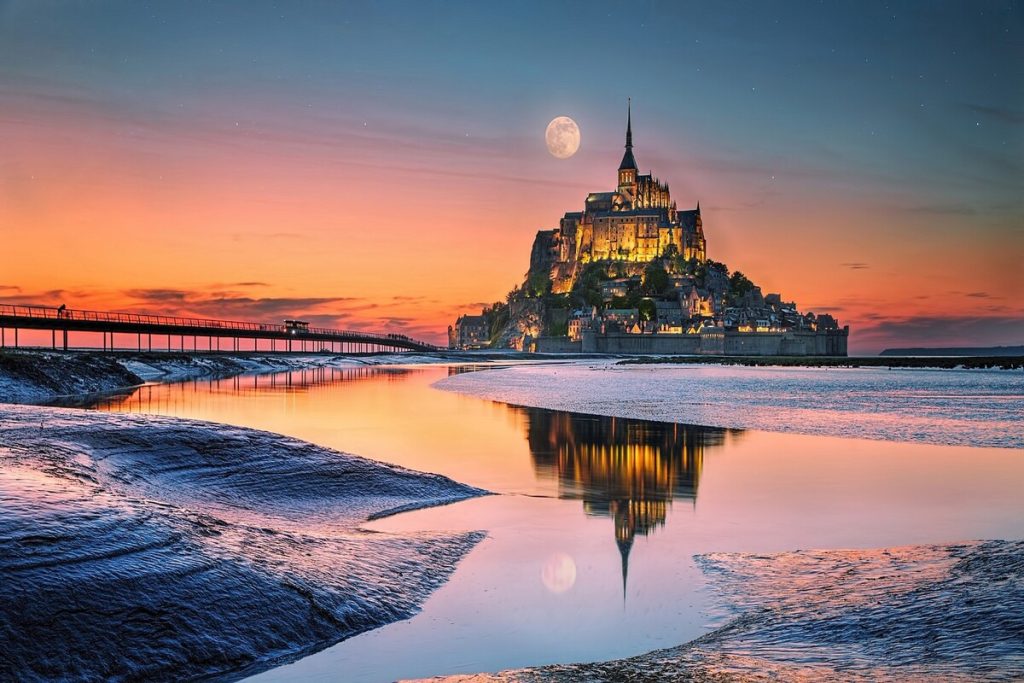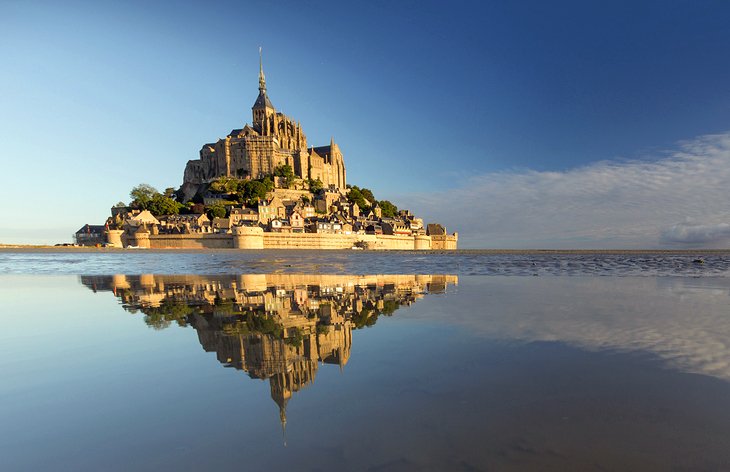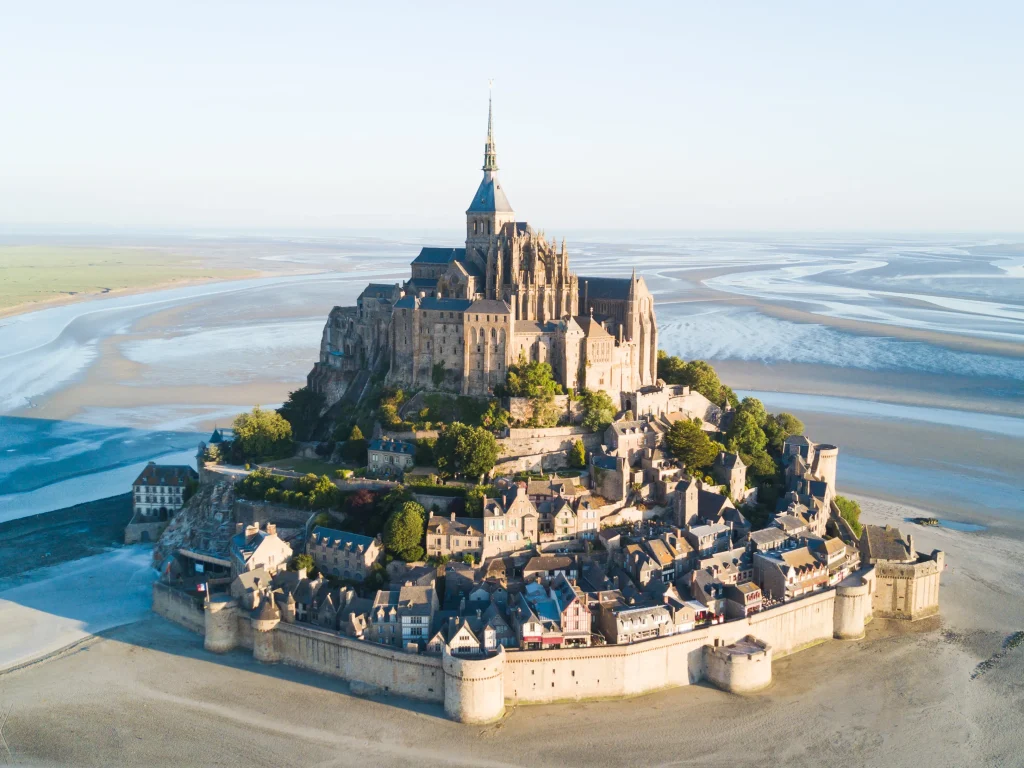Experience the Enchantment of Mont Saint-Michel: A Timeless Wonder

Experience the Enchantment of Mont Saint-Michel: A Timeless Wonder
Experience the Enchantment of Mont Saint-Michel: A Timeless Wonder
Welcome to Mont Saint-Michel, an iconic marvel that stands as a testament to history, architecture, and natural beauty. This article will guide you through the captivating journey of Mont Saint-Michel, providing all the information you need to plan an unforgettable visit to this enchanting island commune in Normandy, France.

A Brief History of Mont Saint-Michel
The Origins: A Sacred Site
Mont Saint-Michel’s history dates back to the early 8th century when the Archangel Michael appeared to Aubert, the Bishop of Avranches, instructing him to build a church on the rocky islet. The construction of the abbey began in 708 AD, and over the centuries, it became a major pilgrimage site, attracting visitors from all over Europe.
Medieval Fortifications
During the Middle Ages, Mont Saint-Michel was a strategic fortress. Its unique position made it a stronghold during the Hundred Years’ War, successfully resisting multiple sieges. The fortifications and military architecture, including sturdy walls and towers, reflect its historical significance as a defensive stronghold.
Evolution Through the Ages
The abbey and its surrounding village continued to evolve, with significant additions during the Romanesque and Gothic periods. The Mont saw the construction of various monastic buildings, culminating in the stunning Gothic abbey that dominates the skyline today. It has served various roles throughout history, including a prison during the French Revolution and the Napoleonic era.
Architectural Marvels of Mont Saint-Michel
The Abbey: A Gothic Masterpiece
The Mont Saint-Michel Abbey is a masterpiece of medieval architecture. The church, with its soaring spire topped by a statue of Saint Michael, is the focal point of the complex. The abbey includes multiple levels, with the church at the top, the Merveille (Marvel) buildings, including the cloisters, refectory, and chaplain’s quarters, as well as the monks’ dining hall and guest hall.
The Merveille
The Merveille, built in the 13th century, is a marvel of Gothic architecture. It consists of three levels, each showcasing different architectural elements. The top level houses the cloister, a serene and contemplative space with beautifully sculpted arcades. The middle level contains the refectory, where monks once dined, and the bottom level includes storerooms and chaplain’s quarters.
The Village
The quaint village that surrounds the abbey is a charming maze of narrow streets, lined with shops, restaurants, and historic buildings. The medieval architecture, with its half-timbered houses and stone structures, adds to the enchanting atmosphere of the Mont. Key sites include the parish church of Saint-Pierre, the medieval ramparts, and the iconic Grand Rue.
Natural Beauty and Surroundings
The Tides
Mont Saint-Michel is renowned for its dramatic tidal variations. The bay experiences some of the highest tides in Europe, with water levels rising and falling up to 15 meters. The sight of the Mont surrounded by water at high tide and emerging from the sandbanks at low tide is truly mesmerizing. Visitors should check tide schedules to experience this natural phenomenon safely.
The Bay
The vast bay surrounding Mont Saint-Michel is a UNESCO World Heritage site, known for its rich biodiversity and scenic beauty. Guided walks across the bay offer a unique perspective of the Mont and an opportunity to explore its diverse flora and fauna. The shifting sands and tidal flats create a dynamic landscape that changes with the tides.
Mont Saint-Michel and Its Ecology
The bay’s unique ecology supports a variety of bird species, making it a haven for birdwatchers. The area’s salt meadows, or “herbus,” are grazed by sheep, producing the famous pre-salé (salt meadow) lamb, a local delicacy. The combination of natural beauty and ecological significance makes Mont Saint-Michel a fascinating destination for nature lovers.
Cultural and Religious Significance
Pilgrimage Site
For centuries, Mont Saint-Michel has been an important pilgrimage site. Pilgrims from across Europe would travel to the abbey to seek spiritual solace and pay homage to Saint Michael. The Pilgrim’s Path, or Chemin des Pèlerins, leading to the Mont, remains a popular route for modern-day pilgrims and hikers.
Religious Ceremonies
The abbey continues to be a place of worship and holds regular religious services. The monks and nuns of the Fraternities of Jerusalem now reside in the abbey, maintaining its spiritual heritage. Special ceremonies and masses, especially on the feast of Saint Michael, attract numerous visitors and worshippers.
Festivals and Events
Mont Saint-Michel hosts various cultural and religious events throughout the year. These include concerts, medieval reenactments, and traditional fairs, providing visitors with a glimpse into the Mont’s vibrant cultural life. The combination of historical ambiance and lively festivities makes these events particularly memorable.

Visiting Mont Saint-Michel
Getting There
Mont Saint-Michel is accessible by road, train, and bus. The nearest major city is Rennes, from where you can take a train to Pontorson, followed by a shuttle bus to the Mont. There is also a parking area on the mainland, with shuttle services or a scenic walk across the causeway to reach the Mont.
Accommodation
Accommodation options range from charming hotels and guesthouses in the village to more modern lodgings on the mainland. Staying overnight allows visitors to experience the Mont in the early morning or late evening, when it is less crowded and most magical.
Dining
Mont Saint-Michel offers a variety of dining experiences, from traditional Normandy cuisine to fine dining. Local specialties include pre-salé lamb, seafood, and the famous omelette at La Mère Poulard. The island’s restaurants and cafes provide a delightful culinary experience with stunning views of the bay.
Guided Tours
Guided tours are highly recommended to fully appreciate the history, architecture, and natural beauty of Mont Saint-Michel. Knowledgeable guides provide insights into the Mont’s past, its construction, and its significance. Walking tours, bay crossings, and audio guides are available to enhance your visit.
Practical Information for Tourists
Best Time to Visit
Mont Saint-Michel is a popular destination year-round, but the best times to visit are during the spring and fall when the weather is pleasant, and the crowds are smaller. Early morning and late afternoon visits provide the best light for photography and a more serene experience.
Accessibility
Due to its medieval architecture and steep, narrow streets, Mont Saint-Michel can be challenging for those with mobility issues. However, efforts are being made to improve accessibility, and certain areas are more accessible than others. It’s advisable to check specific accessibility options in advance.
Safety Tips
Visitors should be aware of the tidal schedules and plan their visits accordingly. Guided bay walks should always be undertaken with an experienced guide to avoid the dangers of quicksand and rapidly rising tides. Comfortable walking shoes are essential for exploring the steep and uneven streets.

Conclusion
Mont Saint-Michel stands as a timeless wonder, a place where history, architecture, and natural beauty converge. Its dramatic silhouette, rising from the tidal waters, continues to captivate and inspire visitors from around the world. Whether you are a history buff, an architecture enthusiast, a nature lover, or a spiritual pilgrim, Mont Saint-Michel offers an unforgettable experience.
Plan your visit to Mont Saint-Michel and immerse yourself in the magic of this iconic destination. Explore its medieval streets, marvel at the architectural masterpieces, and witness the breathtaking tides. Mont Saint-Michel is not just a place to visit; it’s a journey through time and a celebration of human ingenuity and natural wonder. Let the enchantment of Mont Saint-Michel create lasting memories and inspire your wanderlust.
Links
Go To Europe
Go to Asia
Go To Africa
Go to America
-
Experience the Enchantment of Mont Saint-Michel: A Timeless Wonder
Experience the Enchantment of Mont Saint-Michel: A Timeless Wonder Welcome to Mont Saint-Michel, an iconic marvel that stands as a testament to history, architecture, and natural […]




